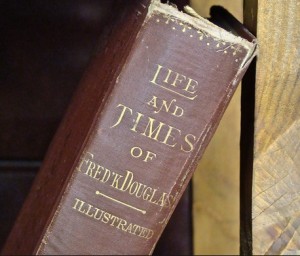“No man can be truly free whose liberty is dependent upon the thought, feeling and action of others, and who has himself no means in his own hands for guarding, protecting, defending and maintaining that liberty”.
Life and Times of Frederick Douglass
Written by himself
Hartford, Connecticut: Park Publishing, Co. 1881.
Life and Times of Frederick Douglass is Douglass’ third autobiography published in 1881 and revised in 1892. In it he revisits events of his previous autobiographies and connects them to later events in his life such as his relationship with John Brown and Abraham Lincoln, his life after the Civil War during reconstruction and his advocacy for women’s suffrage. In this last autobiography he feels free to describe details of his escape from slavery and the transportation means he used, he also names individuals who helped him. In his two previous autobiographies he was unable to discuss this chapter of his life because it would have endangered other fugitive slaves and his own family. He gives details of the Underground Railway and how it worked.
Introduction
The book opens with an introduction by George Lewis Ruffin. Ruffin was the first African American graduate of Harvard Law School, the first African American to be elected to serve on the Boston City Council and the first African American judge in the United States.
Ruffin declares that the most remarkable contribution this country has given to the world is Frederick Douglass. Ruffin in his own words:
Douglas was born a slave, he won his liberty; he is of negro extraction, and consequently was despised and outraged; he has by his own energy and force of character commanded the respect of the Nation; he was ignorant, he has, agains law and by stealth and entirely unaided, educated himself; he was poor, he has by honest toil and industry become rich and independent, so to speak; he, a chattel slave of a hated and cruelly wronged race, in the teeth of American prejudice and in face of nearly every kind of hindrance and draw- back, has come to be one of the foremost orators of the age, with a reputation established on both sides of the Atlantic; a writer of power and elegance of expression; a thinker whose views are potent in controlling and shaping public opinion; a high officer in the National Government; a cultivated gentleman whose virtues as a husband, father, and citizen are the highest honor a man can have.
Content
The book is divided into two parts. Part one is devoted to Douglass’ life as a slave and part two to his life as a free man. Part one has twenty one chapters. Part one starts with the Author’s birth, followed by Removal from Grandmother’s, Troubles of Childhood, A general survey of the slave plantation, A slaveholder’s character, A child’s reasoning, Luxuries at the Great House, Characteristics of overseers, Change of location, Learning to read, Growing in knowledge, Religious nature awaken, The vicissitudes of slave life, The experience in St Michaels, Covey, the negro breaker, Another pressure of the tyrant’s vise, The last flogging, New relations and duties, The runaway plot, Apprenticeship life and Escape from slavery.
Part two contains nineteen chapters. The first chapter is Escape from slavery followed by Life as a freeman, Introduced to the abolitionists, Recollections of old friends, One hundred conventions, Impressions abroad, Triumphs and trials, John Brown and Mrs. Stowe, Increasing demands of the slave power, The beginning of the end, Sessions and war, Hope for the nation, Vast changes, Living and learning, Weighed in the balance, Time makes all things even, Incidents and events, Honor to whom honor and Retrospection.

